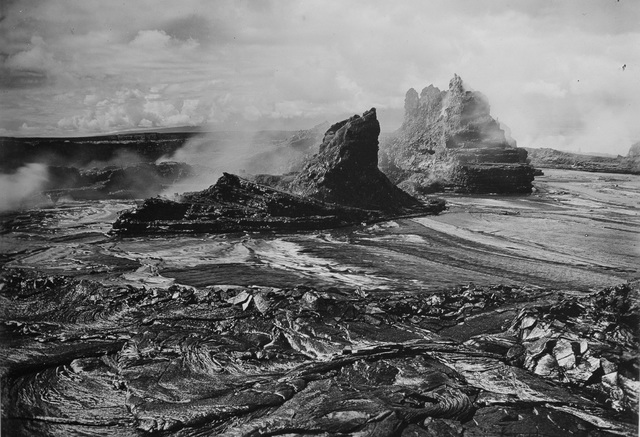The dramatic opening of the Overlook crater within Halema‘uma‘u Crater on March 19, 2008, heralded a new period of activity for longtime Kilauea Volcano watchers.
During the next several years, nearly continuous eruptive activity formed an active lava lake in the new crater. An active lava lake is one that overlies its vent, which constantly supplies and drains lava to and from the lake. This circulation keeps lava in the lake hot and also generally keeps it from spilling from the crater. An active lava lake contrasts with a “passive” lava lake, which simply is a pool of lava formed when lava flows into a depression.
The active lava lake in Overlook crater now is the second largest lava lake on Earth, about 170 m by 220 m (560 ft by 720 ft) across. The lake is more than 100 m (328 ft) deep and Overlook crater itself deepened by 8 m (26 ft) in late April and early May, when overflows onto the floor of Halema‘uma‘u built the rim higher.
Visitors to the summit of Kilauea now are accustomed to the spectacular nighttime glow above the lake as it rises and falls in concert with summit inflation and deflation, as well as with expansion and episodic escape of gas bubbles.
Although relatively new to most of us, churning lava lakes are certainly not new to Halema‘uma‘u Crater. Indeed, from 1823-1924, a lava lake (or lakes) nearly always was present in the caldera, generally inside Halema‘uma‘u. Short-lived lava lakes played in Halema‘uma‘u several times between 1924-68. Much of the time, however, visitors witnessed a scene quite different from today.
As one example, this nearly century-old print (pictured) shows Halema‘uma‘u when much more of its floor was covered by a lava lake compared to today. Towering bodies of solidified lava called “crags” rise above the lake surface like battleships on the sea. At times, these crags were so high they could be seen by spectators at the old Volcano House, nearly 3 km (2 mi) away. Visitors sometimes could view lava fountaining and hear noises of splashing lava from the hotel. Today, the clatter of breaking and falling rocks is, with favorable wind, audible outside Jaggar Museum, and the overflows in April and May were visible from many caldera vantage points.
In the early 1900s, the lava lake inside Halema‘uma‘u resembled a dynamic body of water in many ways. Thomas A. Jaggar, founder of the Hawaiian Volcano Observatory, used terms such as cove, bay and inlet to describe lava pools and other features in the lake. The lava lake typically was impounded by levees made by overflows of lava from the lake, just as overflows of silt-laden water create levees along the Mississippi River.
The above photograph shows what was known as the Southeast Crag, an 11-m- (36-ft-) high peak of solidified lava that twisted and tilted upward. As of yet, we’ve not seen any similar features developed in the current lava lake within Overlook crater. This might be because the present lake is impounded by the walls of Overlook crater, not by its own natural levees, which can change configuration and location with time. If such self-impoundment should develop in the Overlook lava lake, we might once again see crags, bays and inlets.
We will share more of the rich photographic record of Halema‘uma‘u lava lakes from the last century in future Volcano Watch columns. Although they lack the vivid and mesmerizing colors of modern photographs, there is a stark beauty in these crisp, black and white scenes of lava in its myriad forms we find equally compelling.
Kilauea activity update
Kilauea’s summit lava lake level fluctuated during the past week, with changes in summit inflation and deflation, but remained well below the rim of the Overlook crater. During the past week, the lake ranged between 40 and 65 m (130–210 ft) below the current floor of Halema‘uma‘u.
Kilauea’s East Rift Zone lava flow continues to feed widespread breakouts northeast of Pu‘u ‘O‘o. Active flows remain within about 8 km (5 mi) of Pu‘u ‘O‘o.
One felt earthquake was reported on the island of Hawaii in the past week. At 1:07 p.m. June 12, a magnitude-2.3 earthquake occurred 8 km (5.0 mi) east of Waimea at a depth of 13 km (8.1 mi).
Visit the HVO website (http://hvo.wr.usgs.gov) for past Volcano Watch articles, Kilauea daily eruption updates and other volcano status reports, current volcano photos, recent earthquakes, and more; call (808) 967-8862 for a Kilauea summary update; email questions to askHVO@usgs.gov.
Volcano Watch (http://hvo.wr.usgs.gov/volcanowatch/) is a weekly article and activity update written by scientists at the U.S. Geological Survey`s Hawaiian Volcano Observatory.






